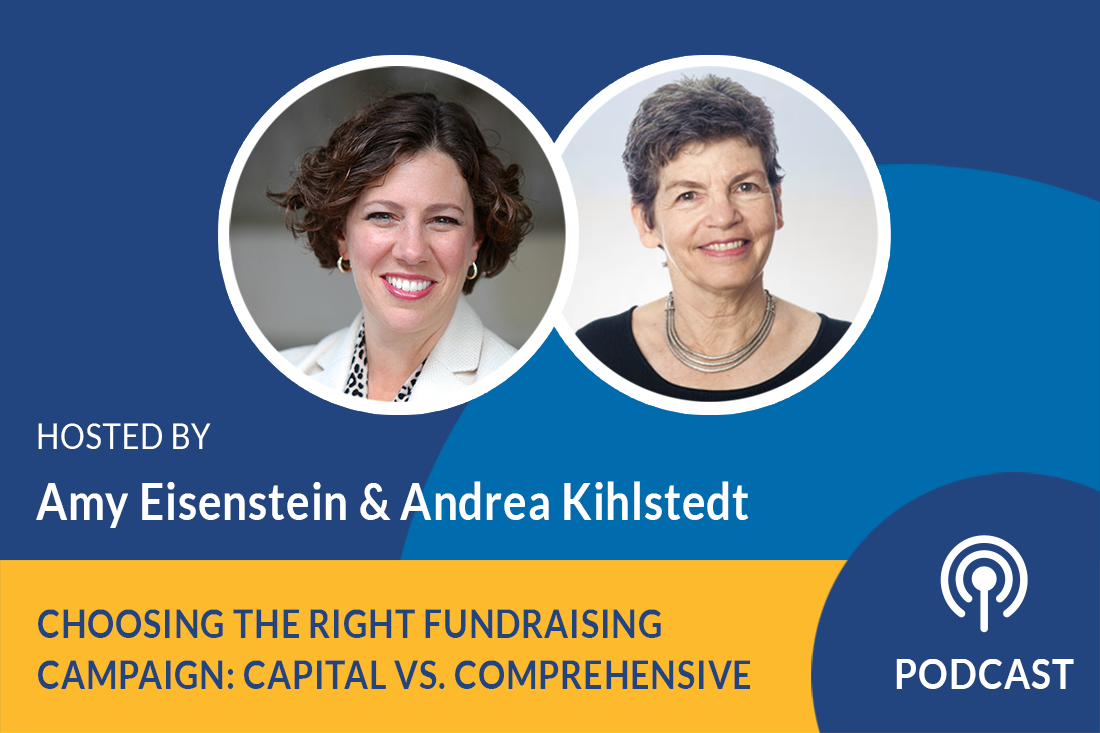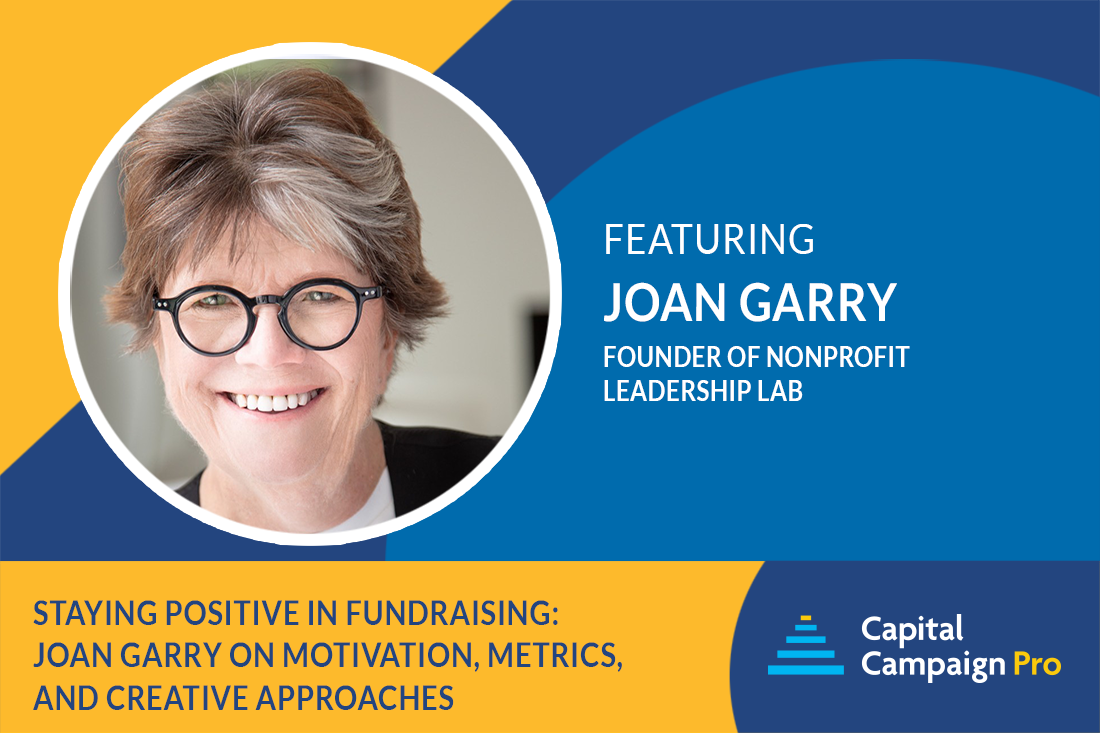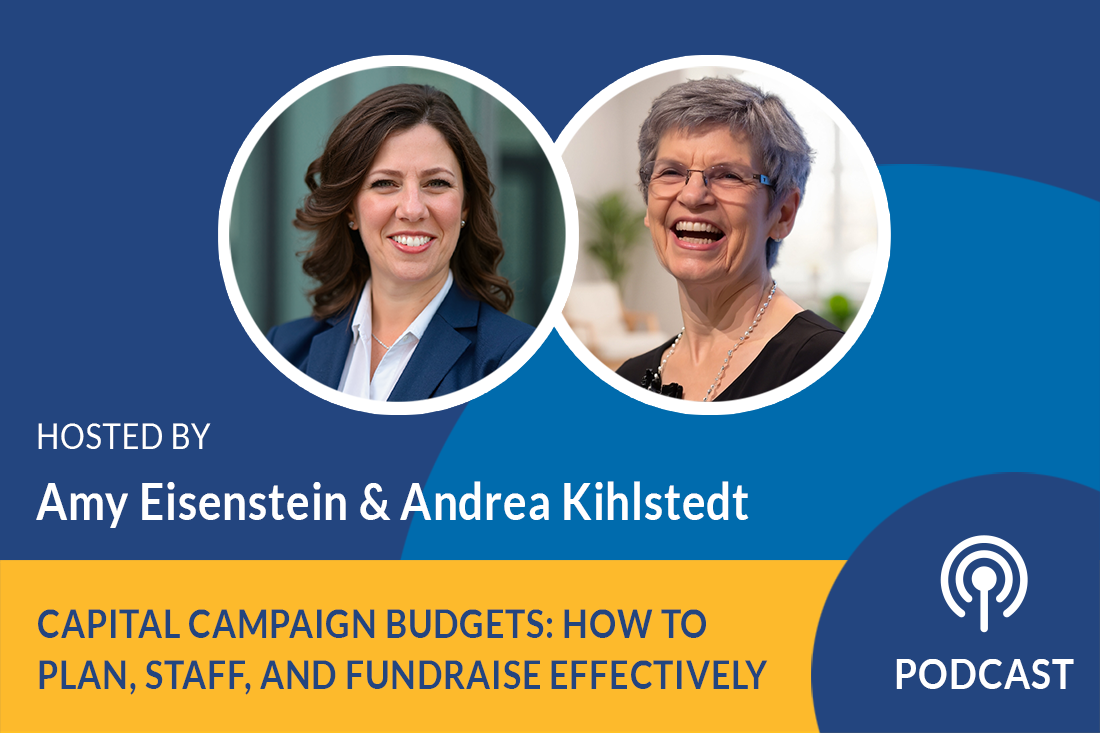Podcast: Choosing the Right Fundraising Campaign: Capital vs. Comprehensive

Season 3, Episode 31
In this episode, co-hosts Amy Eisenstein and Andrea Kihlstedt dive into the intricate world of fundraising campaigns. They explore the key differences between capital campaigns and comprehensive campaigns, helping you understand which one might be the right choice for your organization.
Amy and Andrea discuss the pros and cons of each approach, considering factors like donor loyalty, organization type, and the impact on accounting and stewardship. They offer insights into when to choose a capital campaign, particularly for smaller, community-based organizations, and when a comprehensive campaign may be more suitable, as is often the case with universities.
Listen Now:
Andrea Kihlstedt:
Have you ever wondered what the difference is between a capital campaign and a comprehensive campaign?
Amy Eisenstein:
Hi, I’m Amy Eisenstein. I’m here with my colleague and co-founder, Andrea Kihlstedt. And we are going to be talking about the difference between comprehensive and capital campaigns and how you should think about which one might be right for your organization.
Capital Campaign vs. Comprehensive Campaign: Primary Differences
So Andrea, let’s get started with the difference, the primary differences between comprehensive and capital campaigns.
Andrea Kihlstedt:
Amy, this is such a great topic because I think most everyone is confused about it. So let’s see if we can make it a little simpler anyway. Here’s the difference…
A capital campaign is usually a targeted campaign, often to build a building or to do something that you can wrap your arms around, something you can see, something that is specific, that a donor would give to that when it is done, when it is built, it will increase the capacity of that organization in a significant way.
Maybe they’ll be able to serve twice the number of students or help twice the number of animals in their community or whatever it is. It’s going to be something you can point to specifically, a building or usually these are building campaigns or an expansion or —
Amy Eisenstein:
Yeah, a program or a project —
Andrea Kihlstedt:
… program or project, but they’re not vague. They’re quite specific, and they are aimed at enabling the organization to be able to do more good in their community.
Amy Eisenstein:
Yeah, right. And that’s a capital campaign.
Okay, so a comprehensive campaign.
Andrea Kihlstedt:
A comprehensive campaign combines whatever they’re doing in terms of new programs or facilities or expansions along with other things. It usually also includes endowment and perhaps new program funding. But most importantly, it includes the revenue from the annual fundraising for the years of the campaign.
So if the campaign, for example, is going to have a three-year pledge period, a comprehensive campaign will estimate how much money the organization is likely to bring in for its annual fund for those three years. And then it will increase the goal of the campaign by that amount, so that every gift to the annual fund will also count towards the campaign.
Amy Eisenstein:
Right. So to me, that is the key differentiator between a capital campaign, because you started to say in a comprehensive campaign, of course it includes endowment and other things. But often capital campaigns for specific projects also include a component of endowment. So I don’t want that to be the distinguishing factor. To me, it’s the annual fund.
If you’re including every dollar that comes into your organization, that’s what defines a comprehensive campaign, is you are counting every dollar in the door for any project, for any program, for endowment, for annual fund, for your buildings, for your programs, for your projects.
But a capital campaign is much more specifically focused on capacity building — often through a building or a renovation, but not always, as you said. But capital campaigns also often include endowments. So I just don’t want… We’re trying to be clear, so let’s be clear.
Capital Campaign vs. Comprehensive Campaign: Which to Do?
All right, so let’s think through some of the reasons that an organization might pick to do a comprehensive campaign versus a capital campaign. We might frame it as pros and consequence, I think they are pros and consequence. But an organization considering any type of campaign will need to pick whether or not they’re including everything or being project or building specific. So how should they think about this or what are some of the reasons to do one versus the other?
Andrea Kihlstedt:
Well, I’ve always been a proponent of capital campaigns as opposed to comprehensive campaigns. That’s just my personal view on the subject.
A lot of consultants are really proponents of comprehensive campaigns, so it’s interesting to look at well, why would you do one rather than the other? And I think if you talk to people who are proponents of comprehensive campaigns, what it turns out is that if an organization has a very loyal donor base, like for example, a university or a school where people have great heartfelt connection to that institution. And that connection, really they’re not looking for the institution to do something spectacular or different for their campaign. They just want to see the institution grow and continue to get better.
So donors like that need less in terms of a focus on a specific project than other kinds of organizations would. Now in organizations like that, with these long, deep, loyal donors are likely to be happy to give to a comprehensive campaign where everything they give, whether they give a special gift to the campaign and more annual fund, for them, lumping it all together and having it all count towards the campaign, it just helps them. They don’t really care so much which dollar goes where. They want all of their dollars to go to making their institutions stronger. And for that, a comprehensive campaign is really the way to go.
Amy Eisenstein:
And I think the most frequent example of that, of course, are universities and colleges. I think that that’s where donor loyalty is the longest. Think about anniversary, class gift campaign type of things, so universities as a group do comprehensive campaigns.
An Example of a Capital Campaign
All right, so let’s talk about smaller, more local community-based organizations.
Andrea Kihlstedt:
Yeah. So I’ve just been talking to the director of the Montauk Lighthouse, the Historical Society out there. They just renovated the lighthouse. They did a campaign to raise money to renovate their very famous lighthouse. You probably know of it, the Montauk Lighthouse. There are pictures of it everywhere it seems, on almost every ad. They did a capital campaign specifically for that.
Now it wouldn’t have made very much sense for them to have a comprehensive campaign for that because they were raising money specifically to renovate that iconic landmark that everybody could focus on everybody knew about, everybody feels strongly about, people want to give to. And to make that less targeted with a comprehensive campaign really would’ve made little sense. They had an annual fund, but it wasn’t a very robust annual fund. But they had real juice, inviting people specifically to help renovate the structure that was compromised and needed renovation to survive.
Amy Eisenstein:
Right. I think that’s a perfect example because most people in the community probably aren’t supporters for the long term of a historic site like that. There’s some dedicated loyal people who love that and are their loyal annual fund donors. But when an exciting project comes along, like renovating the lighthouse, you’re going to get the whole community involved. And the more specific and targeted you can be, the more successful you’re going to be.
If you’re really good at what you do, you may keep some of those donors giving to your annual fund post campaign. But having something targeted and specific is really going to rally the community, and that’s exactly what happened.
Andrea Kihlstedt:
I think that’s such a good point, Amy. Imagine a typical community member who knows about and cares about that project and wants to see that building look fantastic and last for a long time, they may not be donors to the organization in an ongoing way. But give them an opportunity to make a significant gift towards that particular aspect of what they do, they may well step in. For that kind of an organization, that kind of a project, you really don’t want to do a comprehensive campaign. You want to do a narrower, more focused capital campaign.
An Example of a Comprehensive Campaign
Now let’s come up with an example of a comprehensive campaign.
Amy Eisenstein:
Well to me, the most obvious example of comprehensive campaigns of course are universities. So one currently college that we’re working with, they’re doing multiple buildings. They are doing dormitories and science laboratories and gymnasiums and annual fund and anniversary campaigns, reunion classes. And so they’re of course doing a comprehensive campaign. They’re doing scholarship and endowment and professor chairs and everything’s lumped in. And that’s a perfect example of a comprehensive campaign.
I actually wanted to move and talk to some of the more tangible, concrete reasons that organizations might pick one versus the other.
So something that you might not think about is something as simple as accounting and stewardship. And how when you keep your capital campaign budget and income separate and apart from your annual fund, for a small organization, it’s much more clear and obvious and specific when these two things are separated out rather than being lumped together. So really thinking about some of the practical systems and infrastructure that you have to sort through some of these things. What are your thoughts on that?
Andrea Kihlstedt:
I think that’s right. I think comprehensive campaigns are easy for the donor and hard for the development office. They’re easy for the donor in that you can ask for one gift and then the development office decides where they’re going to count it, how they’re going to divvy up that gift to count it in one place or another. And the development office and the accounting office, the finance office, they have to do all kinds of wrangling to figure that out and to be very, very clear. But for the donor, it’s easy, “I’m going to give $50,000 to this campaign. Do with it what you want,” right?
Amy Eisenstein:
Yes, I don’t know. I’m not as sure. I actually think that it’s easy for the donor to say:
“All right, I’ve been $1,000 a year donor, so I’m going to continue to give to the annual fund $1,000 a year, plus I’m going to make a special one time gift over and above that to this special project of $5,000 a year.”
So I could make the argument from the other side as well, because then at the end of the campaign, how does the donor know what they’re giving for the annual fund if they’ve lumped it all together?
Andrea Kihlstedt:
So that’s actually one of the reasons that people in development offices like comprehensive campaigns.
Amy Eisenstein:
It raises people’s sights.
Andrea Kihlstedt:
Because they want to mush it all together. They want people to forget that they’re giving $1,000 a year because let’s say that you move them in the campaign up to $5,000 a year. That you go to them and say, “Will you consider $5,000 a year for the next three years?” And they don’t parse it out. $1,000 is for annual fund and $4,000 is for the campaign. They say, “It’s just a $5,000 a year campaign gift.” What they’re hoping to do is to get people used to giving $5,000 a year. So at the end of the campaign, they go to them and say, “Now wouldn’t you like to continue at this level and make this your regular annual fund gift?”
Why to Separate Campaign Gifts from the Annual Fund
Amy Eisenstein:
So Andrea, I think you’ve just made a very strong case for comprehensive campaigns, and we’re going to have a very hard time convincing any of our clients to do anything else. So if you don’t want everybody transitioning to a comprehensive campaign, I think you’re going to need to come up with some alternatives because I think in the past you’ve always been such a strong supporter of separating them out. So why should people separate it out?
Andrea Kihlstedt:
I still am, Amy. I’ll tell you why. And because this story that I just related about, the $5,000 gift, to me, it feels like hoodwinking people. To me, the lack of clarity, to me, the right thing to do at the end of the campaign would be to say to the donor:
“You have given a wonderful campaign gift of $5,000 a year for the last five years. In the past, you had given $1,000 a year for your annual fund gift. Would you consider increasing that going forward?”
Not just sort of sneaking it in. Now even if you’re doing a capital campaign, you can go to your donors at the end of their campaign and say:
“Listen, you have been giving both to the annual fund and to the campaign, your campaign gift. You have paid off your campaign gift, would you consider increasing your annual fund gift?”
There’s no reason, except that one is much clearer than the other. One to me, feels like hoodwinking people and the other feels like being clear and honest and direct. So now don’t get me wrong, many consultants don’t agree with me. Let me be really clear, all right.
Amy Eisenstein:
Well, so here’s what I’m concerned about with that strategy with regard to comprehensive campaign, moving people up a level or two for the campaign. To me, that doesn’t actually get them to dig deep for the special projects. It just seems like raising their annual fund gift for a special campaign or an anniversary year.
So while you may get an increased gift long-term, I’m not sure that you actually get the big campaign gift when they’re separate and very specific. So I think there are lots of ways to look at it.
Andrea Kihlstedt:
Well, that’s why this topic is confusing, Amy. It’s confusing for everyone. Even when you and I talk about it, everyone can hear how that we go around in circles about it. And we know what we’re doing in this campaign world, we have been around this topic a lot.
Comprehensive Campaigns Make More Sense for Some Educational Institutions
So here’s what to know about it. It is not easy or simple to parse whether comprehensive campaigns or straight capital campaigns are better or worse. What I do believe is true is this, if your campaign is for an educational institution that has deep, long alumni relations and of people who give year after year and who are likely to care more about the institution as a whole than about a particular project that the institution is doing, then you should seriously consider a comprehensive campaign.
If however, your organization is not that kind of organization, if your organization is building a brand new building, you’ve never had a building before, this is an exciting opportunity to move your programs into a new building, and you don’t have that kind of alumni loyalty in your relationship with your donors, then probably a capital campaign is what you should be doing.
The Bottom Line
Amy Eisenstein:
So here’s the bottom line. Whatever you pick, you need to be crystal clear in your campaign policies as to what you’re counting and when you’re counting and how you’re counting it and how you’re recognizing donors. And so to me, it’s less critical about what you pick and how clear you are both internally and externally, so that everybody understands what’s going on and what you’re raising money for.
So whoo, that was a long-winded round and round discussion of comprehensive and capital campaigns. But I think it’s a good starter conversation and it’s a good thing for development directors and executive directors to raise these issues with their board members so they can make the best choice for their institution.
Andrea Kihlstedt:
Right. Amy, I just want to say one more thing about this. Sometimes what happens is that you have an organization like the Montauk Lighthouse, something which focuses on a specific project, and it’s clear that that should be a capital campaign. But you have either a Development Director or a board member or two that come out of having been involved in a comprehensive campaign for their university, and they assume that’s the right model.
So just be aware that there are differences between these two and the people who come out of universities will lean towards comprehensive campaigns, and that may not be the right strategy for you.
Amy Eisenstein:
Excellent. Well, thank you so much for joining us. I hope you learned a lot or at least found it entertaining. And we’ll see you next time.



Leave a Comment